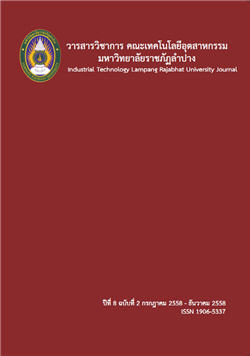12. ผลของคลื่นความถี่อัลทราโซนิคส์และเวลาต่อประสิทธิภาพ ในการล้างใบเลื่อยลันดา
DOI:
https://doi.org/10.14456/itjlp.2015.22Keywords:
ใบเลื่อยลันดา, การล้างด้วยคลื่นอัลทราโซนิคส์, ความถี่และเวลา, ประสิทธิภาพในการทำความสะอาด, Handsaw blade, Ultrasonic cleaning, Frequency and time, Cleaning efficiencyAbstract
งานวิจัยนี้ได้ออกแบบและสร้างเครื่องล้างระบบอัลทราโซนิคส์ในปี พ.ศ.2558 เพื่อใช้ในการศึกษาอิทธิพลของความถี่และเวลา ต่อประสิทธิภาพในการทำความสะอาดใบเลื่อยลันดา ส่วนประกอบหลักของเครื่องประกอบด้วย ถังล้างทำด้วยเหล็กกล้าไร้สนิมขนาดปริมาตรที่พอเหมาะ ติดตั้งหัวสั่นทรานสดิวเซอร์ (Transducer) ใต้ตัวถัง 4 ชุดเรียงตามแนวยาว เป็นที่ให้กำเนิดคลื่นอัลทราโซนิคส์ความถี่ตามต้องการ การทำงานของเครื่องควบคุมโดยวงจรอิเล็กทรอนิกส์พร้อมหม้อแปลงไฟฟ้า บรรจุภายในกล่องเหล็กกล้าไร้สนิมติดตั้งเคียงข้างกับตัวถัง สร้างถังล้างแบบเดียวกันจำนวน 2 ถัง ด้วยความถี่ 28 และ 40 kHz จัดการทดลองแบบแฟคทอเรียล (Factorial) ประกอบด้วย 2 ความถี่ดังกล่าว และเวลาที่ใช้ในการล้าง 4 ระดับ (15 30 45 และ 60 วินาที) รวมมี 8 กลุ่มการทดลอง (Treatment) ใช้แผนการทดลองแบบสุ่มสมบูรณ์ (Completely randomized designed) จำนวน 3 ซ้ำ ล้างโดยใช้น้ำประปาที่อุณหภูมิห้อง (≈30°C) ทั้งนี้เพื่อความสะดวกในทางปฏิบัติ พร้อมทั้งได้ทดลองการทำความสะอาดใบเลื่อยด้วยวิธีปกติควบคู่กันไป จำนวน 3 ซ้ำ เพื่อการศึกษาเปรียบเทียบ ก่อนและหลังการล้างได้ทำการประเมินความสะอาดใบเลื่อยด้วยการดูด้วยตาเปล่า กล้องจุลทรรศน์ และการวิเคราะห์อนุภาคปนเปื้อนบนผิวเลื่อยด้วยโปรแกรมอิมเมจเจ (Image J)
ผลการทดลองพบว่า การทำความสะอาดใบเลื่อยด้วยวิธีปกติใช้เวลาเฉลี่ย 307 วินาที ถึงแม้ใบเลื่อยมองดูสะอาดตา แต่จากการวิเคราะห์พบว่ายังคงมีอนุภาคปนเปื้อนอยู่ร้อยละ 4.27 บนผิวใบเลื่อย โดยปริมาณของอนุภาคที่ลดลงเท่ากับร้อยละ 56.9 หลังจากการทำความสะอาด ส่วนการล้างด้วยคลื่นอัลทราโซนิคส์ ผลปรากฏว่าความถี่และเวลามีอิทธิพลอย่างมีนัยสำคัญต่อความสะอาดของใบเลื่อย อนุภาคปนเปื้อนบนผิวลดลงอย่างรวดเร็วภายในเวลา 15 วินาที หลังจากนั้นได้ลดลงอีกอย่างช้า ๆ ตามระยะเวลาที่เพิ่มขึ้นของการล้าง เมื่อเปรียบเทียบกับความสะอาดที่ได้จากวิธีปกติการล้างด้วยวิธีอัลทราโซนิคส์ใช้เวลาเพียง 15 วินาที โดยที่อนุภาคปนเปื้อนคงค้างบนผิวใบเลื่อยมีน้อยกว่า คิดเป็นปริมาณที่ลดลงเท่ากับร้อยละ 73.1 และร้อยละ 79.3 ด้วยการล้างที่ความถี่ 28 และ 40 kHz ตามลำดับ นอกจากนั้นยังพบว่า การล้างด้วยคลื่นอัลทราโซนิคส์ มีผลทำให้ร่องฟันเลื่อยมีความสะอาดมากกว่าเมื่อเปรียบเทียบกับการทำความสะอาดด้วยวิธีปกติ
Effects of Ultrasonic Wave Frequency and Time on Handsaw Blade Cleaning Efficiency.
The present research was conducted using an ultrasonic cleaning system which was designed and constructed in 2015 to investigate the influence of frequency and time on the efficiency of handsaw blade cleaning. The main system consisted of a stainless steel tank equipped with 4 sets of transducers generating precise frequencies which were situated in a row at the bottom of the tank. The system was operated and controlled electronically with a transformer installed beside the tank. Two identical tanks with transducers operating at 28 and 40 kHz were constructed. Eight factorial treatments consisting of the 2 frequencies and 4 cleaning times (15, 30, 45 and 60 seconds) were assigned in a completely randomized design with 3 replications. Tap water at room temperature (≈30°C) was utilized as the cleaning medium. Conventional cleaning was carried out concurrently 3 times as a comparison. Before and after cleaning, the saw blade cleanliness was evaluated by visual inspection and microscopy. The quantity of contaminated particles adhering to the blade surface was determined by Image J programming.
The results showed that it took an average of 307 seconds to clean the blades conventional. Though they appeared clean to the naked eye, 4.27% of the blade surface contained contaminated particles. After cleaning, contamination was decreased by 56.9%. The results of ultrasonic cleaning showed that handsaw blade cleanliness was significantly influenced by frequency and cleaning time. The amount of contaminated particles decreased rapidly after 15 seconds of cleaning and then slowly declined as cleaning time increased. To achieve a similar appearance to that observed using the conventional methods required only 15 seconds of ultrasonic cleaning, which resulted in lower quantities of blade surface contamination. The decreases in contaminant were 73.1% and 79.3% with 28 and 40 kHz cleaning frequencies respectively.






